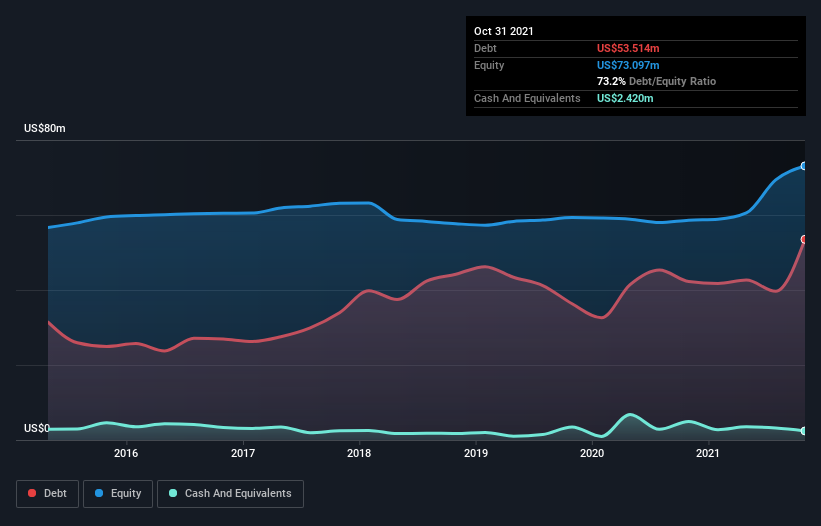- United States
- /
- Electronic Equipment and Components
- /
- NasdaqCM:SGMA
Does SigmaTron International (NASDAQ:SGMA) Have A Healthy Balance Sheet?

Some say volatility, rather than debt, is the best way to think about risk as an investor, but Warren Buffett famously said that 'Volatility is far from synonymous with risk.' When we think about how risky a company is, we always like to look at its use of debt, since debt overload can lead to ruin. Importantly, SigmaTron International, Inc. (NASDAQ:SGMA) does carry debt. But is this debt a concern to shareholders?
When Is Debt Dangerous?
Generally speaking, debt only becomes a real problem when a company can't easily pay it off, either by raising capital or with its own cash flow. Ultimately, if the company can't fulfill its legal obligations to repay debt, shareholders could walk away with nothing. While that is not too common, we often do see indebted companies permanently diluting shareholders because lenders force them to raise capital at a distressed price. Of course, plenty of companies use debt to fund growth, without any negative consequences. The first thing to do when considering how much debt a business uses is to look at its cash and debt together.
View our latest analysis for SigmaTron International
What Is SigmaTron International's Debt?
As you can see below, at the end of October 2021, SigmaTron International had US$53.5m of debt, up from US$42.3m a year ago. Click the image for more detail. However, it does have US$2.42m in cash offsetting this, leading to net debt of about US$51.1m.

A Look At SigmaTron International's Liabilities
We can see from the most recent balance sheet that SigmaTron International had liabilities of US$113.2m falling due within a year, and liabilities of US$63.9m due beyond that. On the other hand, it had cash of US$2.42m and US$60.4m worth of receivables due within a year. So its liabilities outweigh the sum of its cash and (near-term) receivables by US$114.3m.
The deficiency here weighs heavily on the US$53.6m company itself, as if a child were struggling under the weight of an enormous back-pack full of books, his sports gear, and a trumpet. So we'd watch its balance sheet closely, without a doubt. After all, SigmaTron International would likely require a major re-capitalisation if it had to pay its creditors today.
In order to size up a company's debt relative to its earnings, we calculate its net debt divided by its earnings before interest, tax, depreciation, and amortization (EBITDA) and its earnings before interest and tax (EBIT) divided by its interest expense (its interest cover). This way, we consider both the absolute quantum of the debt, as well as the interest rates paid on it.
With net debt to EBITDA of 3.0 SigmaTron International has a fairly noticeable amount of debt. On the plus side, its EBIT was 9.8 times its interest expense, and its net debt to EBITDA, was quite high, at 3.0. Pleasingly, SigmaTron International is growing its EBIT faster than former Australian PM Bob Hawke downs a yard glass, boasting a 1,309% gain in the last twelve months. When analysing debt levels, the balance sheet is the obvious place to start. But it is SigmaTron International's earnings that will influence how the balance sheet holds up in the future. So if you're keen to discover more about its earnings, it might be worth checking out this graph of its long term earnings trend.
Finally, a company can only pay off debt with cold hard cash, not accounting profits. So we clearly need to look at whether that EBIT is leading to corresponding free cash flow. Over the last three years, SigmaTron International reported free cash flow worth 11% of its EBIT, which is really quite low. That limp level of cash conversion undermines its ability to manage and pay down debt.
Our View
Mulling over SigmaTron International's attempt at staying on top of its total liabilities, we're certainly not enthusiastic. But on the bright side, its EBIT growth rate is a good sign, and makes us more optimistic. Once we consider all the factors above, together, it seems to us that SigmaTron International's debt is making it a bit risky. That's not necessarily a bad thing, but we'd generally feel more comfortable with less leverage. The balance sheet is clearly the area to focus on when you are analysing debt. However, not all investment risk resides within the balance sheet - far from it. These risks can be hard to spot. Every company has them, and we've spotted 5 warning signs for SigmaTron International (of which 2 can't be ignored!) you should know about.
At the end of the day, it's often better to focus on companies that are free from net debt. You can access our special list of such companies (all with a track record of profit growth). It's free.
New: Manage All Your Stock Portfolios in One Place
We've created the ultimate portfolio companion for stock investors, and it's free.
• Connect an unlimited number of Portfolios and see your total in one currency
• Be alerted to new Warning Signs or Risks via email or mobile
• Track the Fair Value of your stocks
Have feedback on this article? Concerned about the content? Get in touch with us directly. Alternatively, email editorial-team (at) simplywallst.com.
This article by Simply Wall St is general in nature. We provide commentary based on historical data and analyst forecasts only using an unbiased methodology and our articles are not intended to be financial advice. It does not constitute a recommendation to buy or sell any stock, and does not take account of your objectives, or your financial situation. We aim to bring you long-term focused analysis driven by fundamental data. Note that our analysis may not factor in the latest price-sensitive company announcements or qualitative material. Simply Wall St has no position in any stocks mentioned.
About NasdaqCM:SGMA
SigmaTron International
Operates as an independent provider of electronic manufacturing services in the United States, Mexico, China, Vietnam, and Taiwan.
Good value slight.
Similar Companies
Market Insights
Community Narratives



